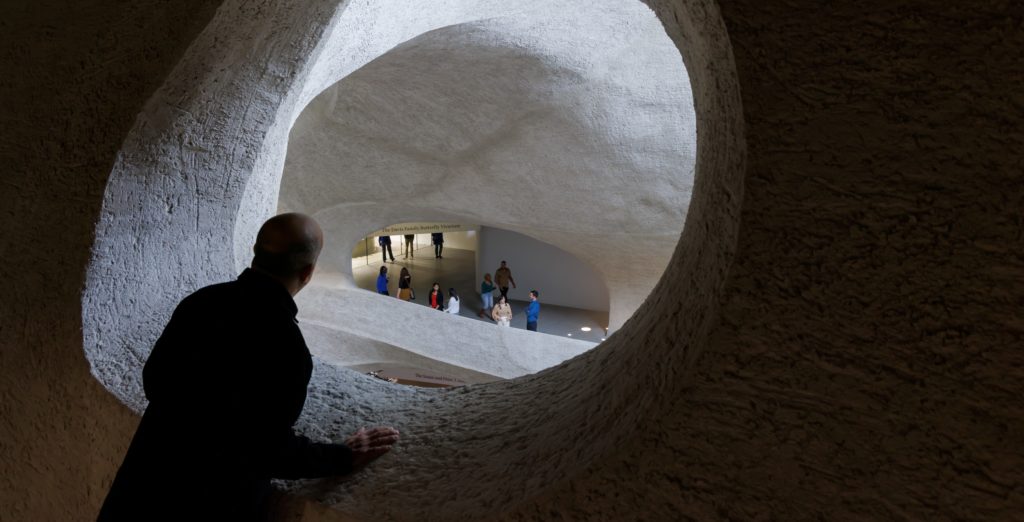Anyone who has walked through the American Museum of Natural History might have sensed something was wrong. Just go through its Hall of Gems and Minerals, or its Hall of South American Peoples, or its Hall of Pacific Peoples. At the end of each of these long rooms, which were only reached through other long rooms, you found nothing less than a dead end. In a way, the reason was by design: the master plan of this museum, founded in 1869 and first envisioned by Calvert Vaux and Jacob Wrey Mould in 1872, has never been fully realized. Much like the Metropolitan Museum of Art, the Brooklyn Museum, and other grand nineteenth-century American edifices, New York’s natural-history museum was laid out on a massive cross-in-square plan, which has only been partially built out over time.
Beyond merely the dead ends, what this means is that, over a century and a half after its founding, the street-facing façades and infill architecture of this museum have been created in a progression of styles that have reflected, for better and worse, the ideals of their times. The museum began on the southern side of its four-block quadrangle bordering Central Park, carved out of the street grid of the then-undeveloped Upper West Side. From 1874 to 1877, Vaux and Mould extended their pastoral vision from Central Park to break ground on the museum’s first wing in the Gothic Revival style; from then until now, this building, which was soon surrounded by future construction, has housed the museum’s Northwest Coast Hall.
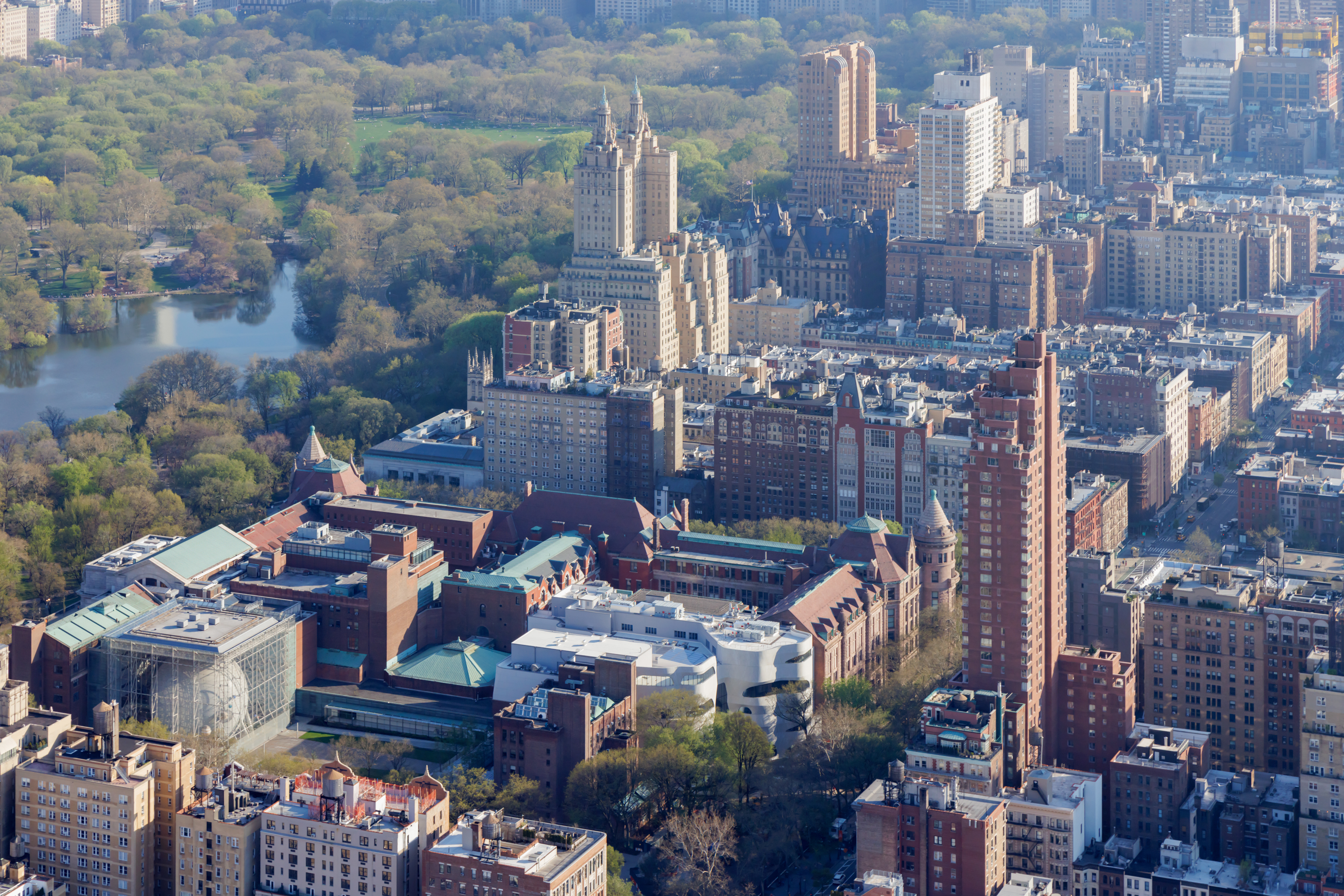
The plan to extend this Gothic language across the four seven-hundred-and-forty-foot sides of the envisioned museum was quickly eclipsed by changing architectural taste. In 1897, a new plan emerged to complete the museum in a Romanesque Revival style. The Seventy-seventh Street façade, designed by Cady, Berg & See and constructed between 1890 and 1900, and the southwest wing, designed by Charles Volz and built between 1906 and 1908, gave the museum its fanciful red turrets and first distinctive appearance.
In the twentieth century, with advances in artificial light and ventilation, these open spaces began to be modified and built in.
The need for natural light and air at one time called for four internal open courtyards located within the circulating wings, all radiating out from a domed central tower. In the twentieth century, with advances in artificial light and ventilation, these open spaces began to be modified and built in. Rather than a dome, the central building became the museum’s lecture hall, designed by Cady, Berg & See in 1900. Wings for ocean life and education filled in the southwest and southeast courtyards in 1924 and 1928. A power and service building of 1930–35 infilled the northwest courtyard. Meanwhile the art-deco Hayden Planetarium, designed by Trowbridge & Livingston, was constructed in the northeast courtyard in 1934–35. At the same time, between 1931 and 1936, the museum’s eastern façade fronting Central Park West received John Russell Pope’s Roman Revival grand vision for the Theodore Roosevelt Memorial Rotunda, complete with a triumphal arch, coffered vaulted interiors, and an equestrian statue of our twenty-sixth president mounted at the center of a monumental entry plaza. Then, over half a century later, a year-2000 addition by Polshek Partnership, which replaced the Hayden with the Rose Center for Earth & Space, stayed within this original master plan while again departing in style, this time resulting in a celestial sphere (housing the new planetarium theater) suspended in an illuminated glass cube.
Despite over a century and a half, and the construction of some twenty-five buildings, the museum has still only filled out about two-thirds of its original master-plan footprint. This incompleteness has been most felt on its western side facing Columbus Avenue, where existing wings have ended abruptly, resulting in many of those back-tracking dead ends. A central building that connects these wings, on all four of the museum’s floors, has long been overdue.
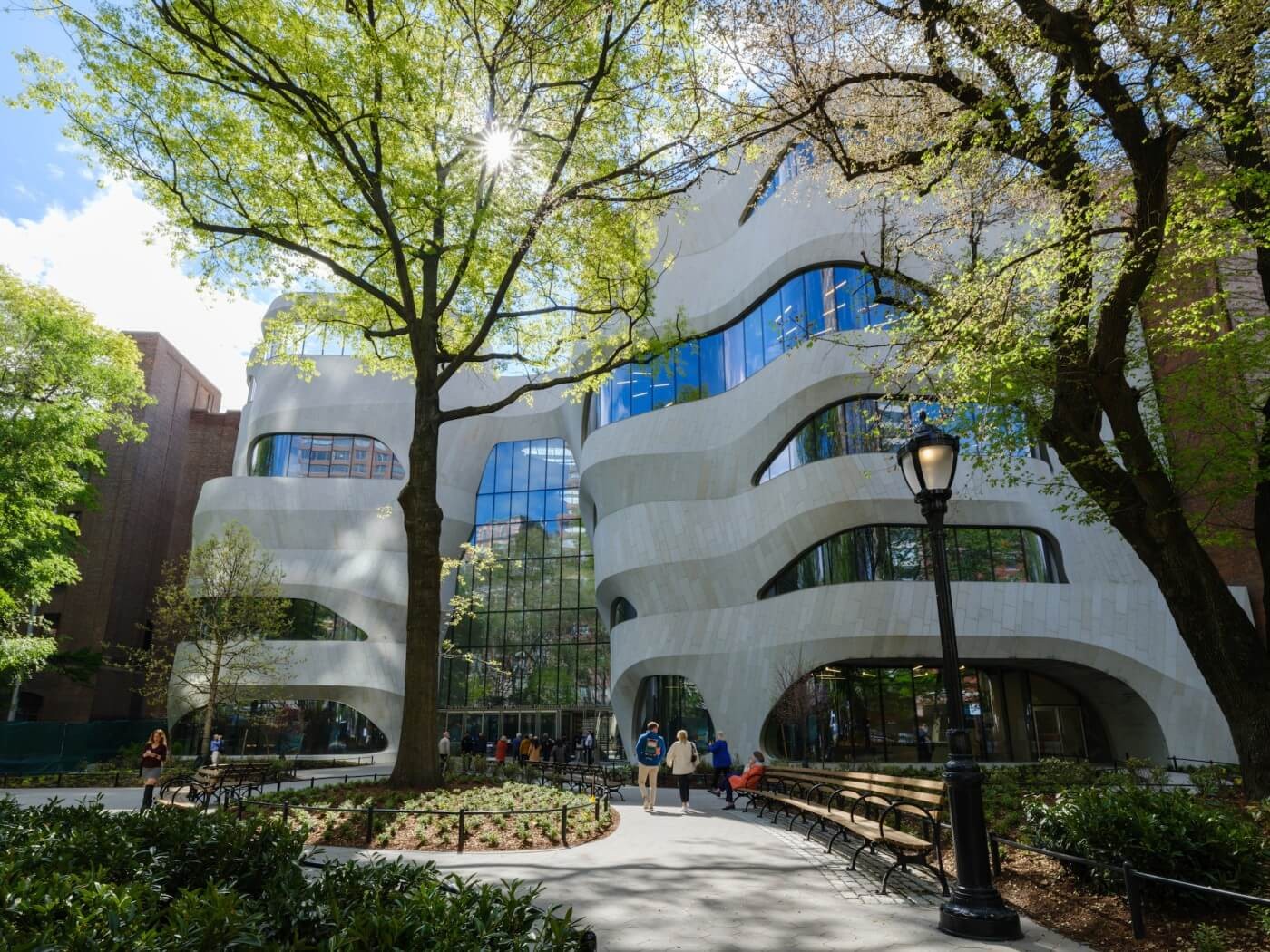
The Richard Gilder Center for Science, Education, and Innovation, over a decade in the making and opened to the public on May 4, set out to do just that. (For more, see “Old museums, new tricks” in The New Criterion of February 2017.) Filling in a void along the museum’s western edge, the 230,000-square-foot wing creates some thirty new access points to the museum’s twenty-building complex. It also generally continues the massing of the original master plan while extending the museum’s central axis west from the Roosevelt Rotunda, resulting in a new façade that now lines up with Seventy-ninth Street.
Funded by one of New York’s great latter-day philanthropists, the Gilder Center is named for the late Republican financier who once teamed up with none other than George Soros to found the Central Park Conservancy. Among the other New York–based beneficiaries of Richard Gilder’s largesse before his death in 2020 were the Gilder Lehrman Institute of American History, the Manhattan Institute for Policy Research, and the magazine you are now reading.
Early on the Gilder Center was designated to expand the museum’s educational mission, with additional classroom space as well as room to display more of the museum’s permanent collection of objects and scientific specimens, of which only 2–3 percent might ever be on view at any given time. Rising over three stories, these new displays, called the Louis V. Gerstner Jr. Collections Core and the Macaulay Family Foundation Collections Gallery, are among the Gilder Center’s most beneficial new additions. Behind the vitrines we can see the new rolling-stack storage shelves where some 12 percent of the museum’s collection, or four million specimens, has been, or is being, relocated. These displays, by Ralph Appelbaum Associates, reveal the breadth and depth of the museum’s holdings while also, for the first time, giving us a window onto its activities as a working scientific institution.
The development of open storage has been an undersung initiative of recent museum practice, one that in fact revives the object-based focus of the Renaissance Wunderkammer, the precursor of our nineteenth-century museums. At the Gilder Center, touch screens and detailed labels tell us much about these slices of the museum’s varied collection. In one area are displays of antique lantern slides, eastern box turtles, giant extinct mammals, wasp nests and galls, cleared and stained fish, New York rocks, Gaia astronomical data, Korean pottery, Maasai beadwork, and even a selection of Vladimir Nabokov’s butterflies. Another floor contains handmade African toys, bats, insects and spiders, parrots, astronomical instruments, amphibians, field documentation, a hadrosaur footprint, crinoid fossils, and the bones of a giant grouper. Still another houses Pueblo pottery, Maya bricks, Camarasaurus vertebrae, animal horns, drill core samples, trilobite fossils, sea-snail shells, megalodon teeth, ammonite fossils, and a captivating display of corals and echinoderms. Nearby, yet another new storage room and study center, visible through a window, now contains a sizeable percentage of the museum’s 3.1 million specimens of moths and butterflies. The one discordant note in all this is “Housewares of the Mao Era,” a display of Communist agitprop that describes the Cultural Revolution as merely a “sweeping campaign to reshape and reeducate Chinese society.” By sweeping away the death of some thirty million Chinese, the museum might satisfy ccp censors, but the appalling omission should not escape our notice.
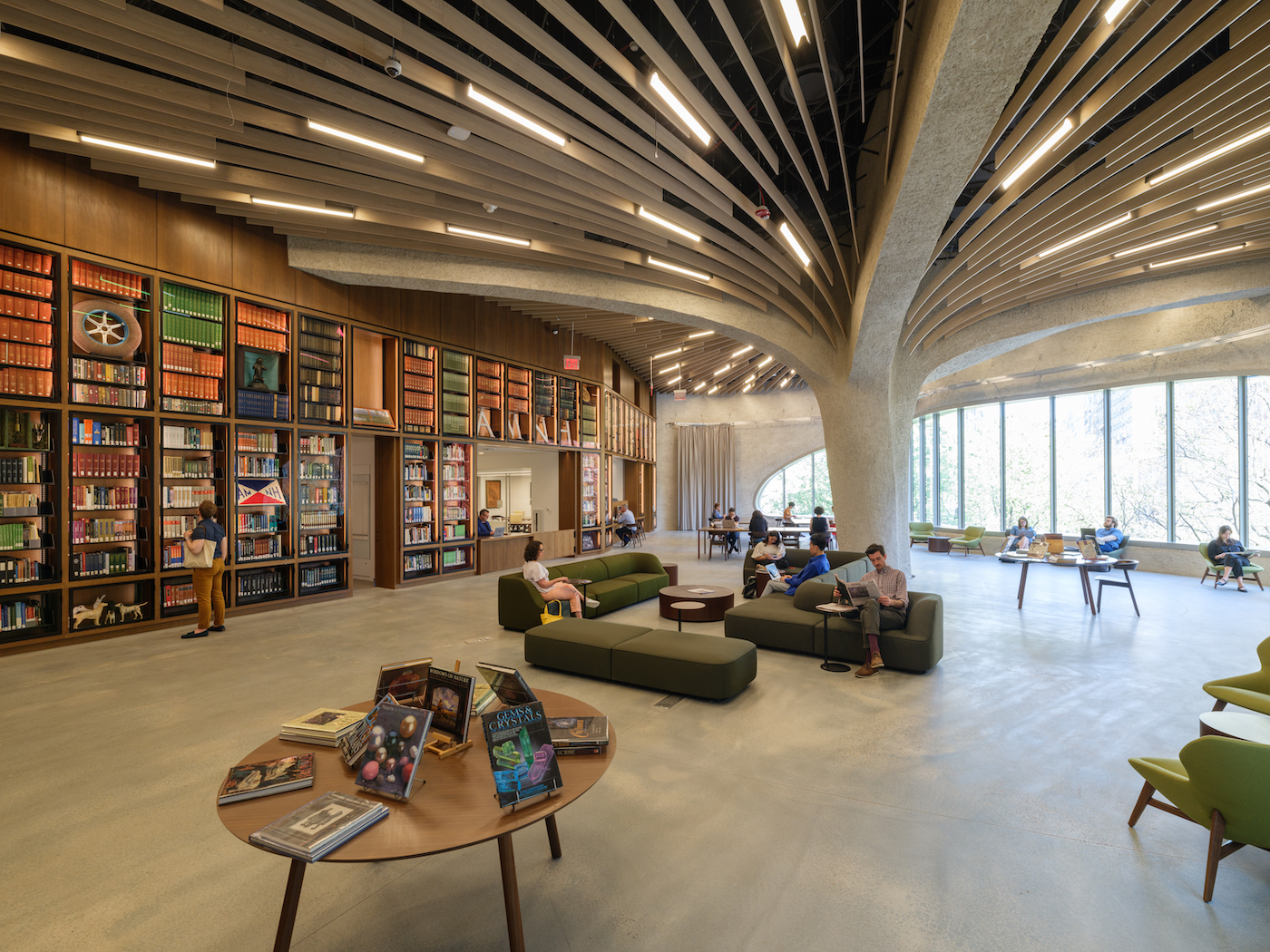
A new library and reading room on the top floor, called the David S. and Ruth L. Gottesman Research Library and Learning Center, continues the spirit of open storage with walls of books and artifacts. The library is another achievement of the Gilder wing, bringing the museum’s extensive bibliographic collection out from a hidden location off of the dinosaur hall into wider and more welcoming public view. A wall of floor-to-ceiling shelves called the “Great Range” contains models of a polar bear from 1912, of a Camarasaurus from circa 1919, and of hms Beagle from circa 2005. Also here is a crate from the museum’s Congo expedition (ca. 1909–15), a museum flag from its land exhibition of 1941, and a lunar tire prototype from 2011. Nearby, for the first time, the library has an alcove to exhibit a selection of its rare books, objects, and manuscripts, such as a 1705 edition of Maria Sibylla Merian’s Metamorphosis Insectorum Surinamensium.
One of the wing’s new permanent exhibits is the five-thousand-square-foot Susan and Peter J. Solomon Family Insectarium. The ground-floor display makes the best case for our buggy acquaintances, whether they be vectors for our diseases—by a wide margin, the mosquito has been the most lethal animal to human life—or the essential pollinators of our food supply. Here the focus is an elaborate terrarium of live leaf-cutter ants walking across ropes and bridges with their snipped loads. A floor up, the Davis Family Butterfly Vivarium relocates the museum’s live butterfly room from its digs in the Whitney Memorial Hall, with historical dioramas Pacific bird life that will now hopefully be restored and reopened, to a more permanent home.
Life’s interconnectedness is a recurring theme of the Gilder Center.
Life’s interconnectedness is a recurring theme of the Gilder Center. A twelve-minute immersive video called “Invisible Worlds,” designed by Tamschick Media+Space with Boris Micka Associates, is a remarkable feat of interactive projection. Still, I am not sure how much insight can genuinely be gleaned from its ambient soundtrack and asmr narration—“humans have created digital networks to extend the reach of our ideas. How many texts have you sent today?” asks a breathy female narrator. More thought-provoking are the touch-screen quizzes in the film’s entry hall, asking whether we are more closely related to mold or moss (the answer is mold, by a difference of some five hundred million years) or sea sponges or starfish (starfish, by two hundred million years).
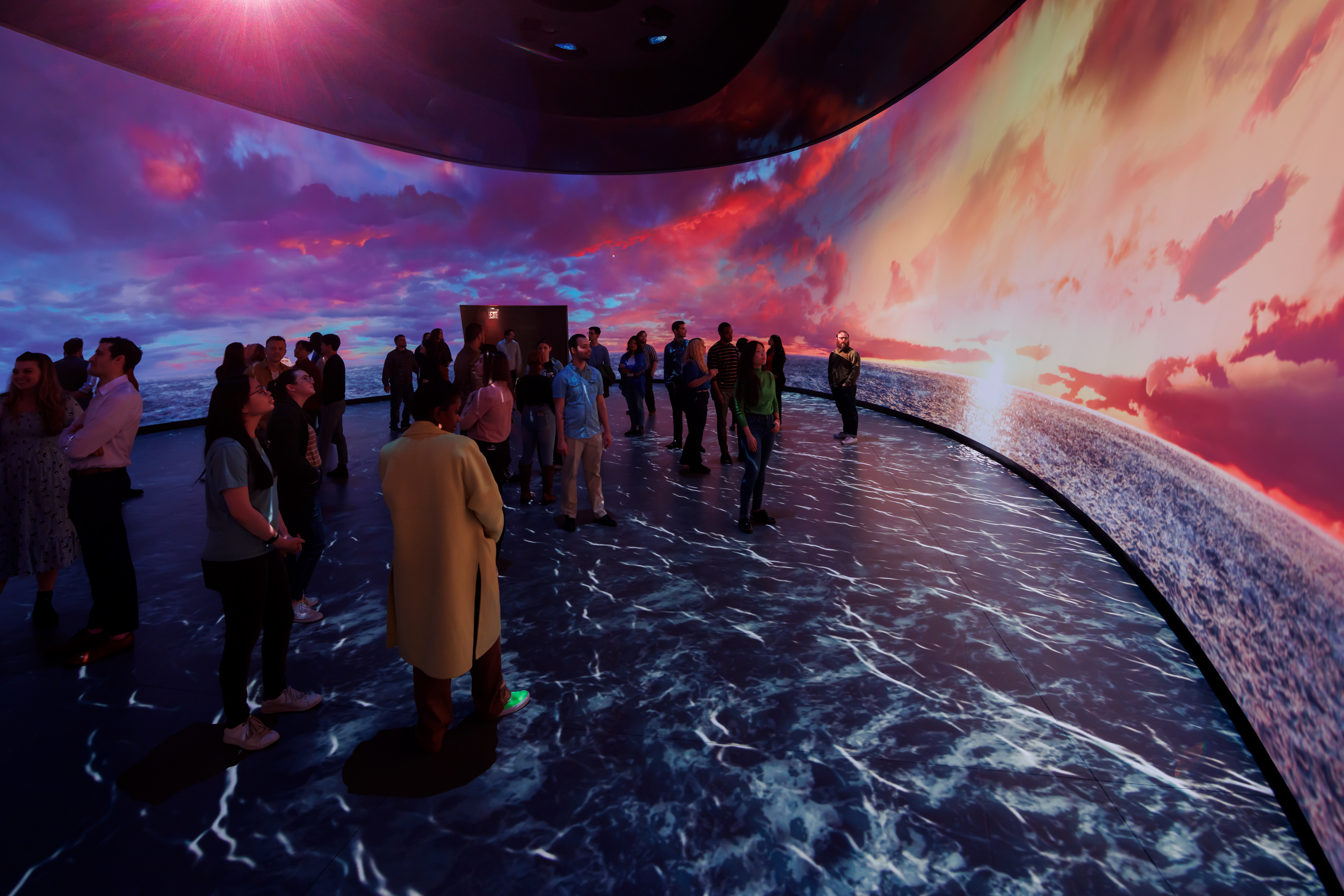
The Gilder Center has tucked its many exhibits and displays around a five-story entry atrium designed by Jeanne Gang that is presented as the showpiece of the project. On the building’s exterior, blocks of Milford pink granite—the very same stone used on Pope’s Roosevelt Rotunda—have been cut by computer into sedimentary wave-like patterns. On the interior, shotcrete, a spray-on concrete used primarily for tunnel construction, has been slathered and scraped onto rebar molds to form the walls and ceilings. The architect has described the forms of this space as being inspired by slot caverns, riverbank canyons, melting blocks of ice, and prehistoric cave dwellings. Its construction is presented as ecologically sensitive in every conceivable way; talk of climate change is never far from the sales pitch. The result is a cross between Antoni Gaudí and Fred Flintstone. This is not to suggest the forms are not arresting. The atrium leads onto a grand staircase by way of Castle Grayskull. Pseudo land-bridges connect the upper floors. The shotcrete surfaces, left scraped and raw, have the look of tufted wool from afar and the feel of coarse-grit sandpaper up close. The walls can catch the raking sunlight in a satisfying sculptural way. In contrast, any knee or hand that catches its sharp and crumbly surface will feel most unsatisfied. I can only imagine how this rough aggregate will age once the first cup of coffee spills down its side and gum sticks to its surface. I fear starchitects, especially those bearing eco-pablum.
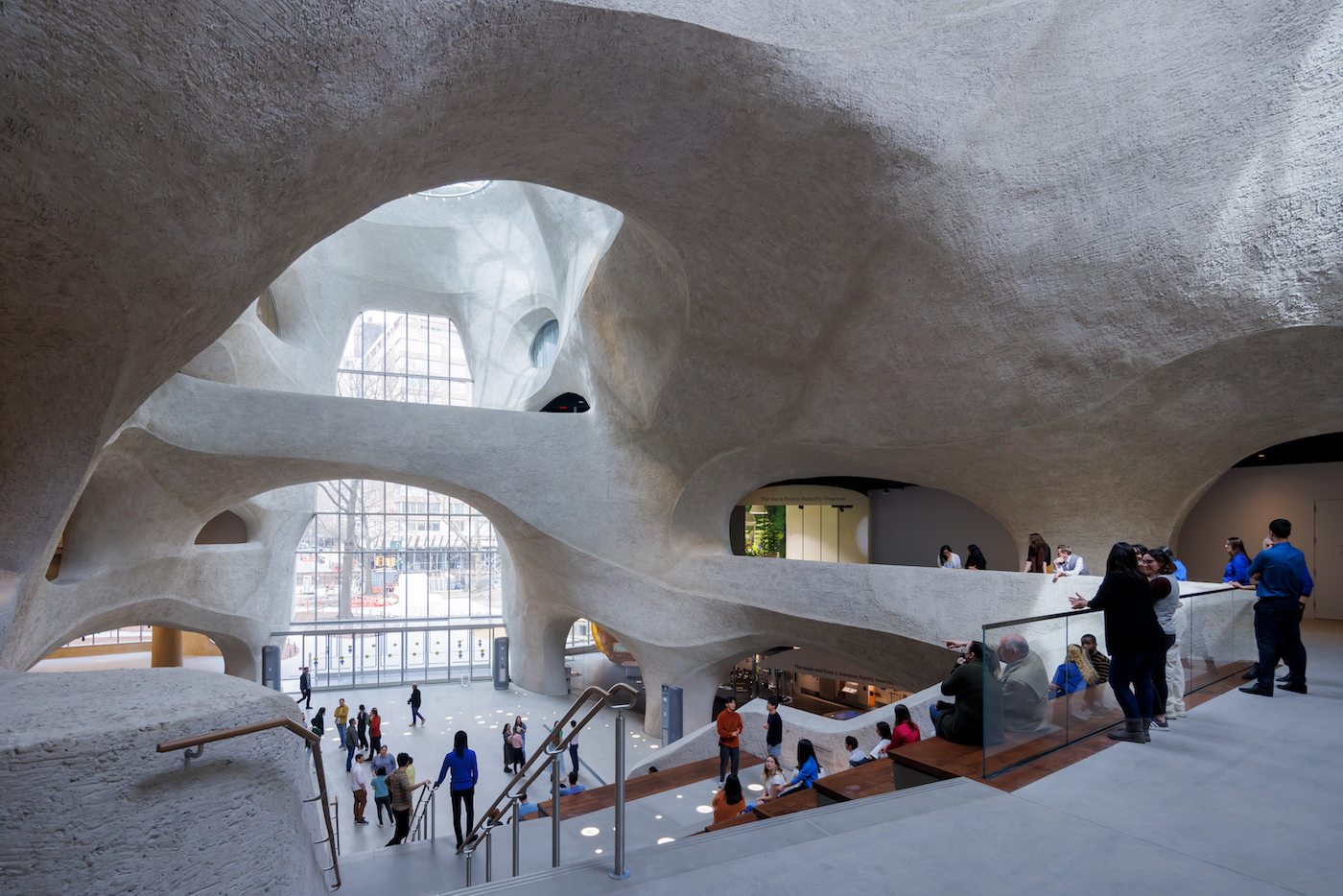
For all of its nature-like forms, this shotcrete architecture is also the most artificial aspect of the new facility. The American Museum of Natural History is known for its historical dioramas. One way to see this design is as a diorama turned inside out, one where we are the specimens on view. It is interesting to note that shotcrete was invented by no less than the naturalist Carl Akeley, the pioneer of the museum’s historical dioramas.
But now the diorama frame is gone. So too is all of the historicized architecture, washed away in the same progressive deluge that recently toppled the Roosevelt statue from the museum’s front stairs. What results is a museum wiped down to the bone. Here is a post-apocalyptic vision where we are no longer the civilized masters of the universe but cave dwellers once again. In our self-obsessed age, perhaps it is appropriate finally to be the subject of this museum’s latest and largest diorama. Just what the five-story display says about the future of humanity is a label yet to be written. If I had my way, to borrow a line popularized by William F. Buckley Jr., I might simply suggest, Don’t immanentize the eschaton. The anthropocene will never kill us, but scientism just might.
